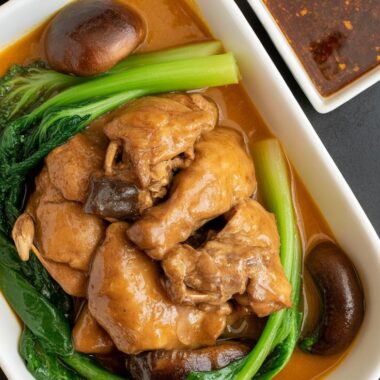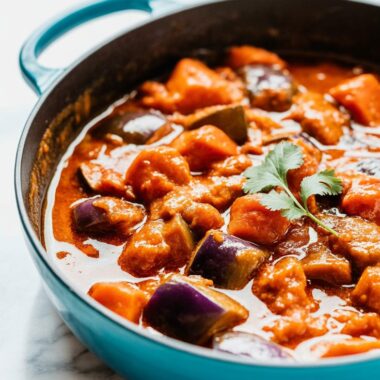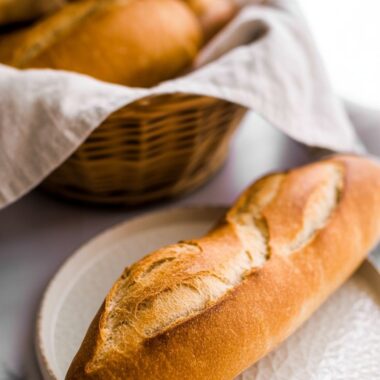This Japanese Chicken Curry is what I’d call the cozy hug of weeknight dinners. It’s hearty, gently spiced, and full of soft chicken, chunky potatoes, and sweet carrots in a thick, flavorful curry sauce. The kind of meal you start craving the moment the weather turns even slightly chilly — or honestly, even when it doesn’t.
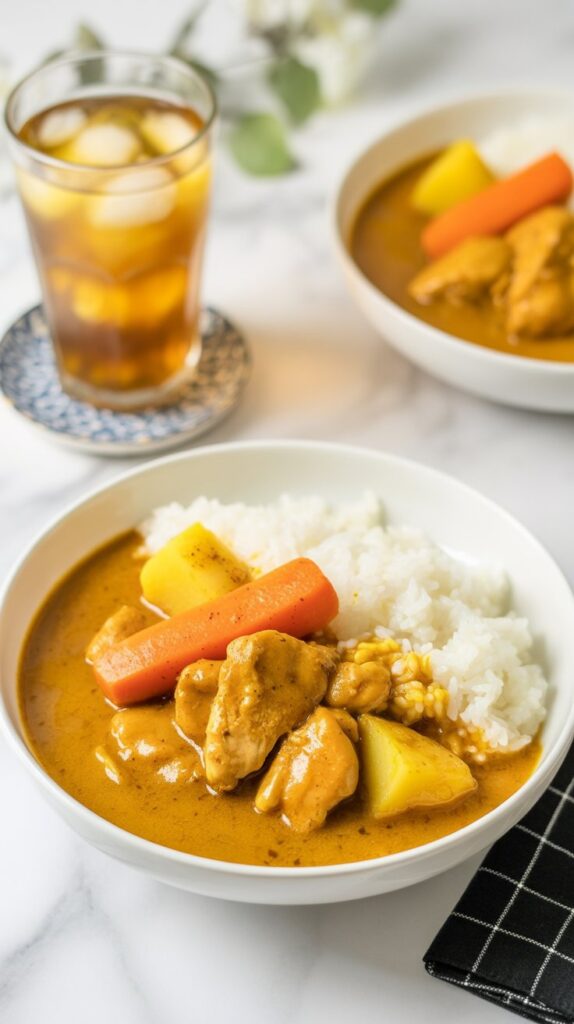
What Makes Japanese Curry So Special?
If you’ve never had Japanese curry before, don’t go in expecting something like Indian or Thai curries. This one’s more like a rich, savory stew with just a hint of sweetness and a silky texture. I always describe it to friends as “comfort in a bowl.”
Back when I was in college and learning how to cook on a budget, Japanese curry was my cheat meal — one box of curry roux, a few vegetables, and some chicken made enough for two days (or three, if I wasn’t too greedy). And the best part? It actually tastes better the next day.
What’s in the Sauce? Let’s Talk Curry Roux
Here’s the secret: most Japanese home cooks don’t make their curry from scratch every time. They use curry roux — those solid blocks that melt into the broth and magically turn it into thick, fragrant curry.
You’ll find these boxes from brands like Golden Curry, Vermont Curry, or Java Curry in Asian grocery stores. Most of them come in three spice levels: mild, medium, or hot. Just a heads-up: even the “hot” version is quite mellow compared to Indian-style heat.
That said, boxed roux can be a bit salty. So if you’re sensitive to that, try using half water and half chicken broth — or even make your own roux from scratch (more on that below!).
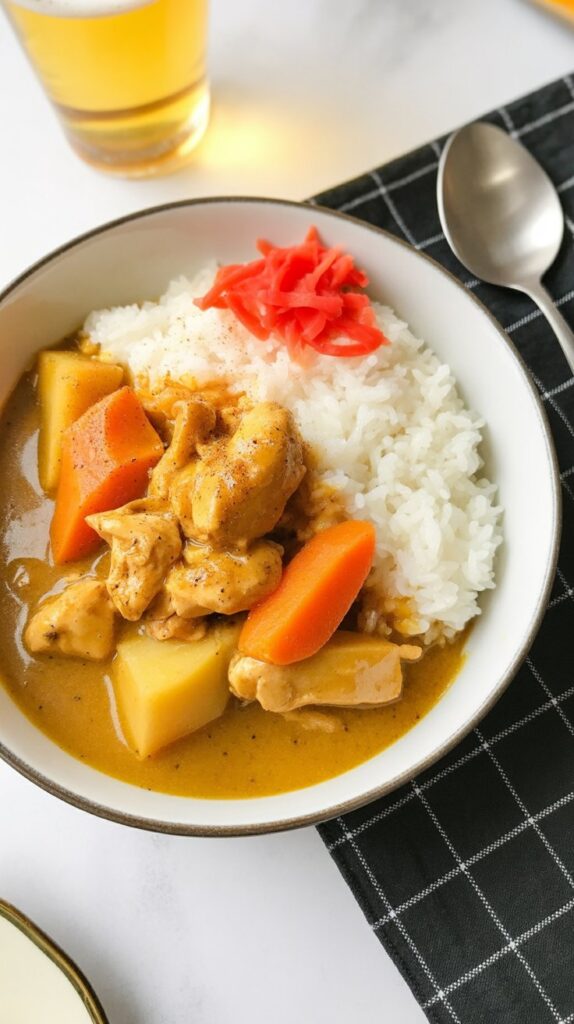
Making Homemade Curry Roux
I didn’t always make curry roux from scratch, but once I tried it, I got hooked. It’s just butter, flour, and a few pantry spices — nothing fancy, but the flavor feels more real and warm.
When I have a quiet Sunday, I’ll make a batch and stash it in the fridge. It’s a life-saver on busy weekdays. And the bonus? You can tweak the heat, the thickness, and the flavor just the way you like it.
My Family’s “Secret” Curry Add-Ins
Growing up, my mom always had a little trick up her sleeve when she made curry. She’d sneak in a bit of grated apple, a spoonful of honey, or a splash of soy sauce. She called them her “magic touches.”
Now, I do the same — not all at once, of course. But adding one or two of these extras really rounds out the flavor. Here are some ideas to experiment with:
- Sweet notes: honey, ketchup, grated apple, or mashed banana.
- Tangy kick: a squeeze of lemon or a spoonful of yogurt.
- Depth: dark chocolate, instant coffee, a knob of butter, or a splash of red wine.
- Fragrance: whole cumin, bay leaf, or curry leaves added early.
You don’t need much — start with just a teaspoon or two, stir it into the broth before adding the roux, and let it simmer.
How I Prep My Ingredients (and Why It Matters)
This dish isn’t fussy, but how you cut the vegetables and meat really changes the texture. Here’s how I do it:
- Chicken: I use boneless thighs and cut them using a slanted slicing method (kind of like butterfly cuts) to give more surface area. This helps the chicken cook evenly and soak up more flavor.
- Carrots: I cut them on the diagonal, rotating them with each slice. This Japanese rangiri style gives more surface to absorb the sauce.
- Potatoes: Yukon golds are perfect — they hold their shape without falling apart.
- Onions: I go with thick wedges and let them get golden. If I have extra time, I caramelize them a bit more for added sweetness.
Tips That Make a Big Difference
Here’s what I’ve learned after making Japanese curry more times than I can count:
1. Brown the Onions Well
Don’t rush this step. Let them get nice and soft and golden. It sets the base flavor.
2. Use Just Enough Liquid
Pour in enough broth to barely cover the ingredients. It shouldn’t look like a soup. The curry will thicken up as everything cooks.
3. Add Your Special Touches Early
If you’re using honey, apple, or any other “secret” ingredient, add it along with the broth. That way, it blends in better.
4. Skim the Broth
When simmering the curry, foam and impurities float to the top. Skim them off — it keeps the sauce clean-tasting.
5. Dissolve the Curry Roux Slowly
I always add two cubes at a time to a ladle filled with hot broth, break them up with a spoon, then stir into the pot. That way, you don’t get surprise chunks of roux later.
6. Stir Often After Adding Roux
Once that curry thickens, it can stick and burn at the bottom if you’re not careful. Keep the heat low and stir every minute or two.

Storing Leftovers and Making Ahead
If you’ve never had day-two Japanese curry, you’re missing out. Something magical happens overnight — the flavors deepen, the sauce gets richer. I always make a big pot just so I can enjoy it again the next day.
That said, if you’re planning to freeze it, take the potatoes out. They turn weird and grainy after freezing.
- Fridge: Lasts 3–4 days.
- Freezer: Up to 1 month, minus the potatoes.
Instant Pot Option
If you’re using an Instant Pot, you can easily cut the simmering time. Pressure cook the meat and veggies first (about 8 minutes on high), then stir in the curry roux at the end on sauté mode.
It’s my go-to on weeknights when I’m juggling dinner and emails at the same time.
What to Serve with Japanese Chicken Curry
This curry goes perfectly with a mound of hot, sticky Japanese short-grain rice. I usually serve it with fukujinzuke — those sweet-and-salty Japanese pickles that cut through the richness. If I don’t have those, I’ll slice up some crisp cucumbers and sprinkle a little salt on them.
A cold barley tea on the side? Perfect.
Japanese Chicken Curry
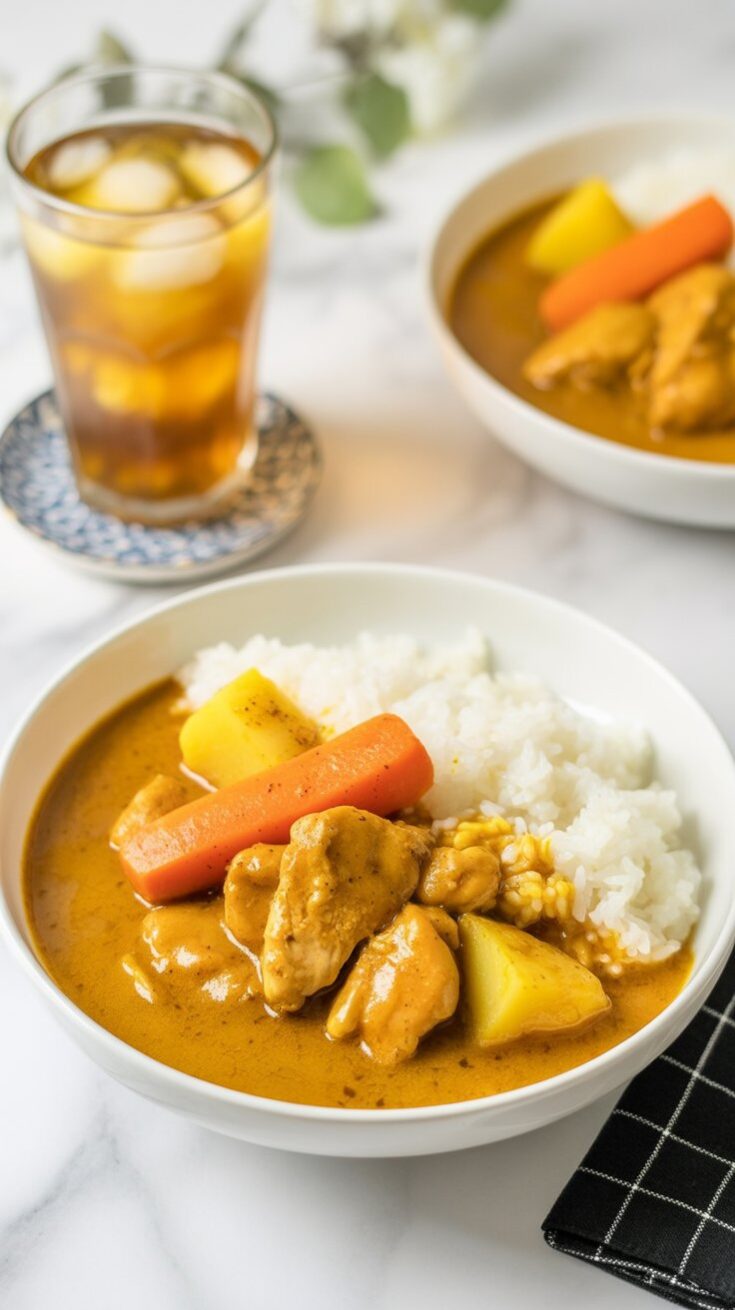
This cozy Japanese chicken curry is everything you crave in a comfort dish—tender chicken, hearty veggies, and a deeply flavorful curry sauce that clings to each bite of fluffy rice.
Ingredients
- 1½ lb boneless, skinless chicken thighs
- 2 large onions
- 3 Yukon gold potatoes
- 2 medium carrots
- 2 cloves garlic, minced
- 1 tsp freshly grated ginger (with juice)
- ½ medium apple (or 1 small sweet apple), peeled and grated
- Freshly ground black pepper, to taste
For the Curry Sauce
- 1½ Tbsp neutral oil (like canola or vegetable)
- 4 cups chicken stock or broth (or half broth, half water)
- 1 Tbsp soy sauce
- 1 Tbsp ketchup
- 1 Tbsp honey
- 1 full package Japanese curry roux (7–8 oz or 200–230 g)
For Serving
- Steamed Japanese short-grain rice
- Fukujinzuke (Japanese red pickles), optional
Instructions
- Prep the vegetables and chicken: Start by cutting the onions into thick wedges—this way, they won’t completely melt into the sauce and will keep some texture. Peel and chop the potatoes into quarters and soak them in water for 15 minutes to remove excess starch. Slice the carrots into chunky, angled pieces (a Japanese cutting style called rangiri that helps them cook evenly).
- Trim any excess fat from the chicken thighs and slice them into bite-sized pieces. Sprinkle with black pepper. Set aside.
- Build the flavor base: Heat oil in a large heavy-bottomed pot or Dutch oven over medium heat. Add the onions and let them sauté until they’re soft and golden, around 5–8 minutes. Try not to stir constantly—they need that golden edge for extra flavor.
- Toss in the garlic and ginger, stir it all together, and let it sizzle for a minute. Then add in the chicken and sear until it's just no longer pink.
- Simmer the curry: Pour in the chicken stock. Add the grated apple, honey, soy sauce, and ketchup. Stir to combine.
- Drop in the carrots and drained potatoes. Keep in mind, if you’re using russet potatoes, wait and add them later, as they tend to break apart if overcooked. Bring everything to a simmer, cover the pot, and cook on medium-low heat for about 15 minutes. Stir occasionally and skim off any foam that forms on top.
- Add the curry roux:Once the veggies are fork-tender, turn off the heat. Scoop a ladleful of the hot broth into a small bowl and dissolve a few cubes of curry roux at a time, then stir it back into the pot. Repeat until all the roux has been added and melted in completely.
- Turn the heat back on to medium-low and simmer the curry uncovered for another 5–10 minutes, stirring often, until it thickens. If it becomes too thick, splash in a bit of water to loosen it. Taste and adjust the seasoning if needed—especially if you're using an unsalted or homemade curry roux.
- Serve it up: Ladle the curry over bowls of hot steamed rice. Add a spoonful of fukujinzuke on the side if you like that tangy crunch. This dish is even better the next day!
- Store leftovers in a glass airtight container in the fridge for up to 3 days, or freeze for up to a month (just skip the potatoes if freezing, as they tend to get mealy). When reheating, the curry will be quite thick—add a splash of water to loosen it up and warm it gently on the stovetop, stirring often.
Notes
- Protein swaps: Try beef, pork, shrimp, tofu, or just stick with extra veggies.
- Vegetable variations: Eggplant, mushrooms, and squash also work beautifully—just add them towards the end of cooking since they don’t need much time.
- Make it vegetarian: Skip the chicken and use veggie broth with tofu or mushrooms. Just add the tofu after the curry roux for the last few minutes to heat through.
Nutrition Information:
Yield: 8 Serving Size: 1Amount Per Serving: Calories: 358Total Fat: 13gSaturated Fat: 3gTrans Fat: 0gUnsaturated Fat: 9gCholesterol: 118mgSodium: 517mgCarbohydrates: 32gFiber: 3gSugar: 9gProtein: 31g
Asianplated.com, occasionally offers nutritional information for recipes contained on this site. This information is provided as a courtesy and is an estimate only. This information comes from online calculators. Although allchickenrecipes.com attempts to provide accurate nutritional information, these figures are only estimates.
Final Thoughts
This isn’t just another curry recipe — it’s something that’s become a part of my home cooking rotation. It’s warm, forgiving, and adaptable. And once you’ve made it a few times, you’ll start tweaking it just the way you like.
Try it this weekend. Your kitchen will smell amazing, and I bet the leftovers won’t last long.
Try other Japanese recipes:

